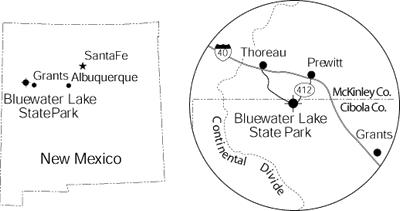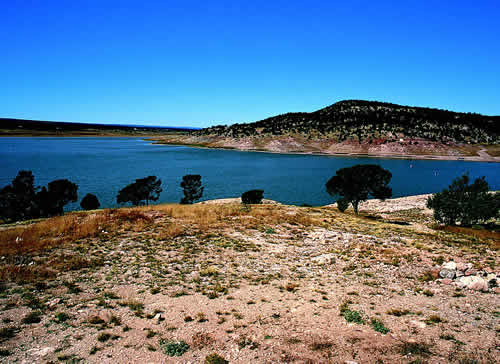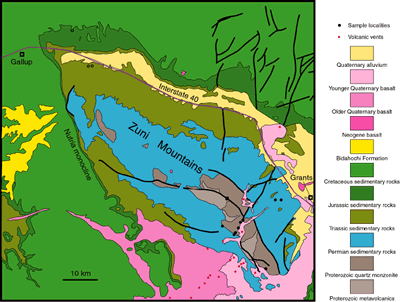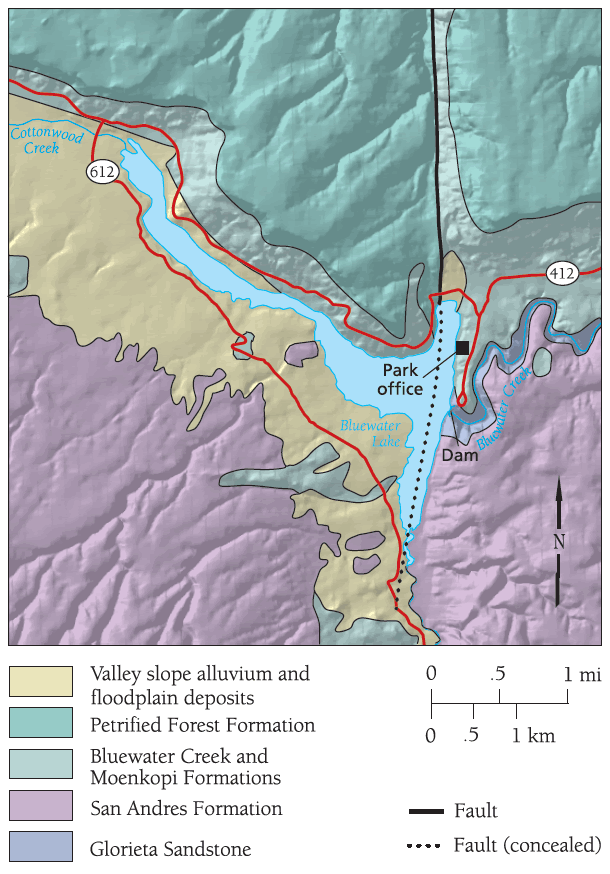
Bluewater Lake State Park
modified and updated from McLemore, V.T., 1998, Bluewater Lake: New Mexico Geology, v. 20, no. 2, p. 44-46.
Introduction


Bluewater Lake State Park lies at an elevation of 7,400 ft in Las Tuces Valley near the Continental Divide in the Zuni Mountains. The park is between Gallup and Grants along I–40, 7 mi southwest of Prewitt via NM-412 (Fig. 1). A forest of cottonwoods, piñon, and juniper surrounds the lake (Fig. 2). The Navajos knew the area as “large cottonwood trees where water flows out” (Julyan, 1996). It became a state park in 1955. Bluewater and Cottonwood (Azul) Creeks feed the lake. The lake itself is formed by an arched dam 90 ft high and 500 ft long (Robinson, 1994) that impounds 38,500 acre-ft of water. The last time water spilled over the dam was in 1941. The dam is convex in the upstream direction for increased strength, and it is at the mouth of Bluewater Creek in a steep-walled canyon. An overlook at the end of the road through the park facilities offers an excellent view of the dam and canyon. A primitive hiking trail leads down into the canyon below the dam.
The New Mexico Department of Game and Fish maintains a permanent pool of water for fish and periodically stocks the lake with rainbow trout and channel catfish. Indeed, the lake is blue, as the name implies. It is well known to ice-fishermen during the winter. Power and sail boating, hiking, water skiing, wind surfing, and swimming are possible recreational activities in addition to fishing, camping, picnicking. Care should be taken driving in wet weather along the north side of the lake because of muddy conditions. Not all 25 mi of shoreline belong to the state park; some land surrounding the lake belongs to private individuals, Indian tribes, and U.S. National Forest. All water, however, is open to the public.
Geology

Bluewater Lake State Park lies in the Zuni Mountains. The Zuni Mountains are considered the southern boundary of the San Juan Basin, an area known for oil, natural gas, uranium, and coal production. The mountains form the core of an elongated structural dome created by regional compressional tectonics during the Cretaceous and early Tertiary periods. Rocks ranging in age from Proterozoic through Recent are exposed in and around the Zuni Mountains (Fig. 3), but only Triassic and Permian strata are exposed near Bluewater Lake; thin veneers of Quaternary alluvium fill valleys draining into the lake (Fig. 4; Anonymous, 1983; Hackman and Olson, 1977; Smith, 1954).
The oldest rocks exposed at Bluewater Lake State Park are assigned to the Permian Glorieta Sandstone that was deposited about 245–268 million years ago. This unit crops out along the canyon bottom of Bluewater Creek and along the hillslopes south of Bluewater Lake. The Glorieta Sandstone consists of massive, white to buff to yellow, quartz sandstones that are erosion resistant and form steep cliffs and hillslopes. The sandstones are typically crossbedded, indicating deposition as eolian dunes and in local stream channels along the shore of the Permian sea that extended across New Mexico. Some units of the Glorieta Sandstone consist of very pure quartz.
Overlying the Glorieta Sandstone in the park are limestones, minor dolomites, shales, siltstones, and gypsum of the Permian San Andres Formation. The upper San Andres limestone beds locally contain fossils (Smith, 1954). The San Andres Formation was deposited along the bottom of the shallow epicontinental Permian sea. At the end of the middle Permian the seas retreated, erosion occurred, and karsting of the San Andres limestone began (Smith, 1954). Karst is a type of erosion where limestone, dolomite, and gypsum are slowly dissolved by rainwater and groundwater. Such dissolution forms irregular, rugged surfaces on outcrops and ultimately creates caves and underground drainage systems in the limestone, dolomite, and gypsum. Collapse of the caves and underground drainages forms the undrained surface depressions called sinkholes. Rugged surfaces and small caves are seen in the San Andres limestone along Bluewater Creek.

By Triassic time, small rivers had formed a broad floodplain where Bluewater Lake State Park now lies. Rocks belonging to the Chinle Group form most of the hills surrounding Bluewater Lake and are approximately 210–225 million years old (Fig. 3; Lucas, 1995; Lucas and Hayden, 1989). The Chinle Group consists of (in ascending order) unnamed basal strata, Shinarump Formation, Bluewater Creek Formation, Petrified Forest Formation, and Owl Rock Formation (Lucas et al., 1997). The Owl Rock and Shinarump Formations are not exposed in the Bluewater Lake area.
The Bluewater Creek Formation is exposed along Bluewater Lake and Cottonwood Creek, upstream of the lake. It consists of grayish-red and reddish-brown sandstones, siltstones, and variegated red, gray, and brown mudstones. This unit is well known to local residents for slick, muddy conditions when wet; uninformed drivers can get their vehicles stuck in these mud bogs along the lake. The Petrified Forest Formation overlies the Bluewater Creek Formation and forms the upper slopes north of Bluewater Lake (Fig. 3). It consists of grayish-white, crossbedded sandstones and red siltstones and mudstones. Rocks in both formations were deposited in continental fluvial and floodplain environments. Crossbedded sandstones were deposited in rivers or streams. Siltstones and mudstones were deposited in floodplains adjacent to rivers and streams. Mudcracks indicate that sometimes the sandstones and mudstones were exposed to drying. The red color is produced by oxidation of iron in the minerals forming the sandstone; this oxidation is common to seasonally dry and seasonally wet arid environments such as existed at the time the Chinle was deposited. Plant fossils are locally common in the Chinle Group and include leaves, petrified wood, leafy shoots, stems, pollen, and woody debris (Lucas et al., 1997). The climate during deposition of the Chinle Group was warm and seasonally humid as evidenced by plant fossils preserved in the unit (Ash, 1989).
There is no stratigraphic evidence of a former natural lake in Las Tuces Valley; instead, it contains a thin veneer of Quaternary alluvium and finer-grained valley-fill deposits formed by ancient rivers or streams. Quaternary alluvium fills the bottom of the canyons and arroyos draining into the lake and along the shores of the lake. Most of this alluvium consists of sand, silt, and clay derived from erosion of outcrops of the surrounding Bluewater Creek and Petrified Forest formations.
The Bluewater fault zone strikes north-south and locally separates Bluewater Creek and Petrified Forest beds from older San Andres beds. The Bluewater fault has a down-to-the-west vertical displacement of 100–400 ft (Smith, 1954). The dam is built along the west-facing fault-line scarp. The lake conceals part of the en echelon fault pattern (Smith, 1954).
References
- Anonymous, 1983, Bluewater Lake: New Mexico Geology, v. 5, no. 1, pp. 14–15.
- Ash, S., 1989, The Upper Triassic Chinle flora of the Zuni Mountains, New Mexico; in Anderson, O. J., Lucas, S. G., Love, D. W., and Cather, S. M. (eds.), Southeastern Colorado Plateau: New Mexico Geological Society, Guidebook 40, pp. 225–230.
- Geologic Map of New Mexico, 2003, New Mexico Bureau of Geology and Mineral Resources, 1:500,000.
- Hackman, R. J., and Olson, A. B., 1977, Geology, structure, and uranium deposits of the Gallup 1º x 2º quadrangle, New Mexico and Arizona: U.S. Geological Survey, Miscellaneous Field Investigations Map I-981, scale 1:250,000.
- Julyan, R., 1996, The place names of New Mexico: University of New Mexico Press, Albuquerque, 385 pp.
- Kelley, S.A., 2003, Laramide exhumation history of the Zuni Mountains, west-central New Mexico, Geological Society of America Abstracts with Programs, v. 35.
- Lucas, S. G., 1995, Triassic stratigraphy and chronology in New Mexico: New Mexico Geology, v. 17, no. 1, pp. 8-13, 17.
- Lucas, S. G., and Hayden, S. N., 1989, Triassic stratigraphy of west-central New Mexico; in Anderson, O. J., Lucas, S. G., Love, D. W., and Cather, S. M. (eds.), Southeastern Colorado Plateau: New Mexico Geological Society, Guidebook 40, pp. 191–211.
- Lucas, S. G., Heckert, A. B., and Anderson, O. J., 1997, Triassic stratigraphy and paleontology on the Fort Wingate quadrangle, west-central New Mexico: New Mexico Geology, v. 19, no. 2, pp. 33–42.
- Robinson, S., 1994, El Malpais, Mt. Taylor, and the Zuni Mountains; a hiking guide and history: University of New Mexico Press, Albuquerque, 276 pp.
- Smith, C. T., 1954, Geology of the Thoreau quadrangle, McKinley and Valencia Counties, New Mexico: New Mexico Bureau of Mines and Mineral Resources, Bulletin 31, 36 pp.
- Young, J. V., 1984, The state parks of New Mexico: University of New Mexico Press, Albuquerque, 160 pp.
Back to State Park Geologic Tours



